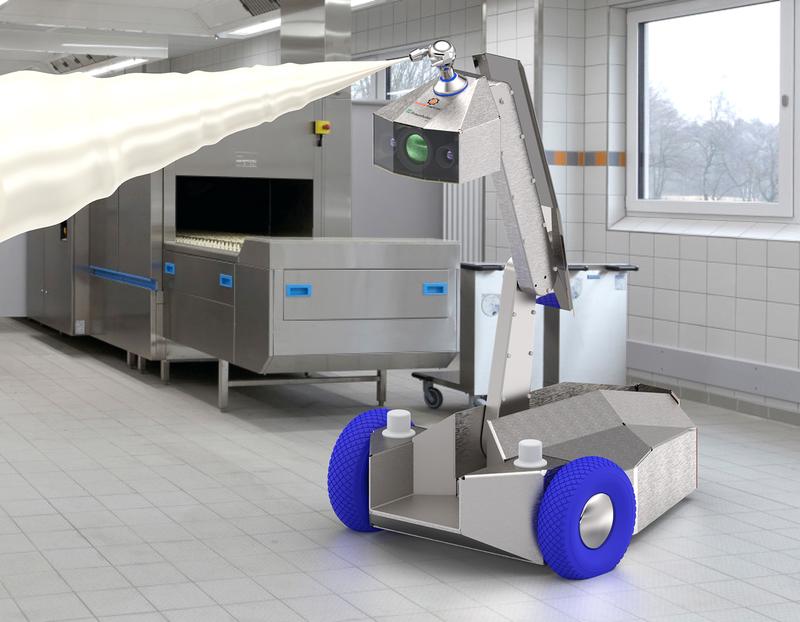
Mobile Robot Cleaner Elevates Hygiene in Food Production

The rotary jet cleaner at the end of Mobile Cleaning Device 4.0’s extendable arm stretches to higher, hard-to-reach spots.
© Fraunhofer IVV
There is no room for compromises when it comes to hygiene in industrial food production. Manufacturing equipment and rooms need regular cleaning.
Biofilms and other fouling deposits may not be allowed to gain purchase under any circumstances.
The success of cleaning efforts has an impact on hygiene and food safety. Although the task of cleaning plants and equipment is demanding and a determining factor of quality, much of this labor is still done manually.
But despite all the vigilance of diligent cleaning crews, their work is hard to reproduce, prone to errors and time-consuming.
Smart robot cleaners for indoors and out
This has prompted a research team at the Fraunhofer Institute for Process Engineering and Packaging IVV in Dresden to develop a modular cleaning robot, two variants of which are now up and running.
One travels down the production line on a conveyor belt, cleaning the equipment from the inside; the other cleans the floor, ceilings and walls of rooms and machines outer surfaces. An extendable robot arm carrying a rotary jet cleaner can stretch to reach high spots on the production line.
This mobile, modular machine with the ability to independently scoot across the shop floor goes by the name of Mobile Cleaning Device 4.0 (MCD). The Fraunhofer IVV has teamed up with the Fraunhofer IOSB-AST at Ilmenau in a research project to look into a multi-sensor system for harsh environments.
It is to be installed in the MCD. This system employs an interesting method called fluorosensing to spot contaminations. The installed sensors scan and calculate the degree of fouling for the robot to adaptively adjust cleaning parameters such as pressure and the amount of foam cleaning agent to suit the situation.
“A detector uses UV light to identify fluorescent particles such as fats, oils and proteins, and doses the foam and water according to the determined parameters, such as the layer thickness and dryness of the residue.
This is to be accomplished by a self-learning AI system that selects the suitable cleaning parameters and specifies the process steps,” says Max Hesse, team leader at the Dresden branch lab for Processing Technology, explaining how this procedure works. A simulation enables a virtual twin to render the data while this process is underway.
“The virtual twin serves to map the detected fouling to a 3D model of the plant. The water pressure can then be adjusted and reduced, depending on the distance between the device and the surface – all in the interest of using resources efficiently.
Sophisticated sensors
The battery-powered robot moves autonomously with nothing but a hose for the cleaning agent connecting to the docking station. It is controlled via Wi-Fi. Advanced sensors paired with AI enable this adaptive cleaning. A radar sensor is able to take readings even through spray, mist and steam. An ultra-wideband sensor gauges the position in the room. A third sensor, an optical fluorosensor, detects fouling and conveys an impression of the object’s geometric properties.
Experts call this visual odometry. The system extrapolates the process parameters from the detected fouling levels and fused sensor data. It also monitors the process on the fly to make sure the cleaning is being done properly. In the next step, it sends the results of its check to the virtual twin with the self-learning capability. This way, the system improves itself with each pass to achieve excellent results while sparing resources.
“Our tests have shown that this can save up to 50 percent on cleaning agents because no more than the actually needed amount is applied to the surfaces,” says Hesse. “The system can be trained to clean as resource-efficiently as possible within a given period, for example, during the nightshift downtime in a factory operating in two shifts. What’s more, there is considerable efficiency potential to be tapped if the skilled workers that had been doing the cleaning can perform other tasks while MCDs handle the paralleled cleaning processes.”
The benefits do not end there: An automated routine documents the entire cleaning process, and all that automation ensures the procedure is highly reproducible.
Agile and flexible – the industry-agnostic Mobile Cleaning Device
The MCD’s application range is not limited to the food industry. This smart robot can serve other lines of business well, for example, the automotive, pharmaceutical, medical engineering, cosmetics and agricultural sectors. Diverse industries can benefit from the autonomous robot cleaners in times of crisis such as the corona pandemic.
“Our automated system really shines when staff is in short supply. Around ten percent of employees in food production are tasked exclusively with cleaning,” says Hesse, an engineer by trade. This requires skilled workers who are scarce even in ordinary times. Both robot variants are evolving as the research continues, so they will be able to execute ever more complex cleaning tasks.
https://www.fraunhofer.de/en/press/research-news/2020/july/mobile-robot-cleaner-…












